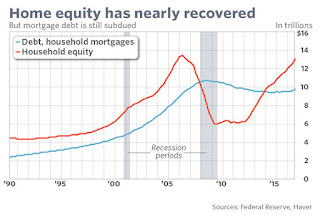Financial FAQs
The S&P CoreLogic Case-Shiller U.S. National Home Price NSA Index, covering all nine U.S. census divisions, reported a 5.6 percent annual gain in October, up from 5.4 percent last month. The 10-City Composite posted a 4.3 percent annual increase, up from 4.2 percent the previous month.
Prices have now returned to 2003-4 levels, according to CoreLogic. That is when housing prices began double-digit increases for several years. The 20-City Composite reported a year-over-year gain of 5.1 percent in October, up from 5.0 percent in September. These are same-home price rises averaged over 3 months to make them less volatile.
But the price rises have leveled off at 5.1 percent on average over the past 2 years, a sign that rising housing inventories are beginning to have an effect on prices after prices soared during the housing bubble years. Portland and Seattle housing prices are still rising at 10 percent per year, with Dallas and Denver close behind.
Rising interest rates may also affect next year’s market, though the 30-year fixed conforming rate is still available @3.875 percent for one origination point in California. But Pending Home sales are the lowest in a year, which are contract signings scheduled to close in approximately 60 days, according to the National Association of Realtors chief economist Lawrence Yun.
“The budget of many prospective buyers last month was dealt an abrupt hit by the quick ascension of rates immediately after the election,” Yun said in NAR’s latest report. “Already faced with climbing home prices and minimal listings in the affordable price range, fewer home shoppers in most of the country were successfully able to sign a contract.”
What about housing’s contribution to economic growth? It is still below trend, at close to 4 percent, whereas it has averaged 5 percent historically. So that’s an additional $18 billion that can be added to GDP growth over the next years if housing sales and construction return to more normal times—but only if interest rates continue to rise gradually.
Trump supporters and Republicans believe the housing market will return to more normal times once they reduce the regulatory burden on housing, which they continue to blame on Dodd-Frank and the Consumer Finance Protection Bureau, for some reason. But these entities have been mostly responsible for the massive settlements with banks that sold falsely advertised AAA rated mortgage securities that created those negatively amortized liar loans, the main cause of the housing bubble.
These settlements should deter lenders from making such risky bets in the future, but what if those Dodd-Frank regulations are abolished by a Republican controlled Congress? Who will then stand in the way of future lending abuses that could once more put tax payers at risk?
Incoming Treasury Secretary Steve Mnuchin has been making noises about resuscitating Fannie Mae and Freddie Mac, the main guarantor of conforming mortgages as private entities, albeit with some revisions to pass part of the lending risk onto banks and other lenders. This may be a good thing in that it could ease the strict qualification standards that have hampered some mortgage lending.
But will that confidence in the Trump administration’s efforts to cut red tape translate into a better (and more affordable) housing market? “NAHB expects an increase in single-family home construction next year, fueled by a growing economy and solid job growth,” said NAHB Chief Economist Robert Dietz. “Moreover, builder confidence has risen on anticipation of reductions in regulatory costs, which is good news for home buyers and renters. However, the pace of construction will continue to be restricted by shortages of lots and labor in some markets.”So though hopes have risen for more housing, all this remains to be seen, in other words.
Harlan Green © 2016
Follow Harlan Green on Twitter: https://twitter.com/HarlanGreen



















